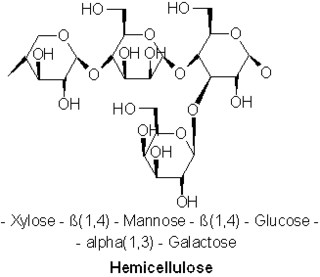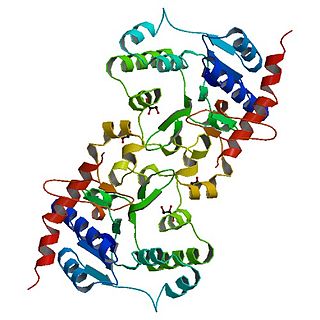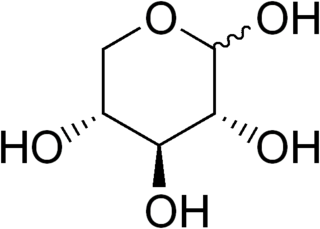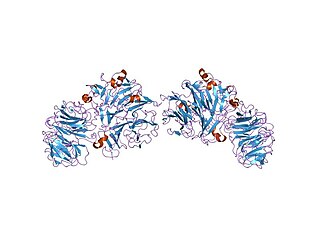Related Research Articles

A hemicellulose is one of a number of heteropolymers, such as arabinoxylans, present along with cellulose in almost all terrestrial plant cell walls. Cellulose is crystalline, strong, and resistant to hydrolysis. Hemicelluloses are branched, shorter in length than cellulose, and also show a propensity to crystallize. They can be hydrolyzed by dilute acid or base as well as a myriad of hemicellulase enzymes.

Glycogenin is an enzyme involved in converting glucose to glycogen. It acts as a primer, by polymerizing the first few glucose molecules, after which other enzymes take over. It is a homodimer of 37-kDa subunits and is classified as a glycosyltransferase.
Xyloglucan is a hemicellulose that occurs in the primary cell wall of all vascular plants; however, all enzymes responsible for xyloglucan metabolism are found in Charophyceae algae. In many dicotyledonous plants, it is the most abundant hemicellulose in the primary cell wall. Xyloglucan binds to the surface of cellulose microfibrils and may link them together. It is the substrate of xyloglucan endotransglycosylase, which cuts and ligates xyloglucans, as a means of integrating new xyloglucans into the cell wall. It is also thought to be the substrate of alpha-expansin, which promotes cell wall enlargement.
In enzymology, a dolichyl-phosphate D-xylosyltransferase is an enzyme that catalyzes the chemical reaction
In enzymology, a flavonol-3-O-glycoside xylosyltransferase is an enzyme that catalyzes the chemical reaction
In enzymology, a globotriaosylceramide 3-beta-N-acetylgalactosaminyltransferase is an enzyme that catalyzes the chemical reaction
In enzymology, a glycoprotein 2-beta-D-xylosyltransferase (EC 2.4.2.38) is an enzyme that catalyzes the chemical reaction
In enzymology, a lipopolysaccharide 3-alpha-galactosyltransferase is an enzyme that catalyzes the chemical reaction

Sucrose-phosphate synthase (SPS) is a plant enzyme involved in sucrose biosynthesis. Specifically, this enzyme catalyzes the transfer of a hexosyl group from uridine diphosphate glucose (UDP-glucose) to D-fructose 6-phosphate to form UDP and D-sucrose-6-phosphate. This reversible step acts as the key regulatory control point in sucrose biosynthesis, and is an excellent example of various key enzyme regulation strategies such as allosteric control and reversible phosphorylation.

In enzymology, a sucrose synthase is an enzyme that catalyzes the chemical reaction
In enzymology, a protein xylosyltransferase is an enzyme that catalyzes the chemical reaction in which a beta-D-xylosyl residue is transferred from UDP-D-xylose to the sidechain oxygen atom of a serine residue in a protein.
In enzymology, a xyloglucan 4-glucosyltransferase is an enzyme that catalyzes the chemical reaction in which a beta-D-glucosyl residue is transferred from UDP-glucose to another glucose residue in xyloglucan, linked by a beta-1,4-D-glucosyl-D-glucose bond.
In enzymology, a xyloglucan:xyloglucosyl transferase (EC 2.4.1.207) is an enzyme that catalyzes the chemical reaction in which a beta-(1,4) bond in the backbone of a xyloglucan in broken; the xyloglucanyl segment is then transferred to the O4 of the non-reducing terminal glucose residue of either xyloglucan or an oligosaccharide thereof.

Xylosyltransferase 1 is an enzyme that in humans is encoded by the XYLT1 gene.

Xylosyltransferase 2 is an enzyme that in humans is encoded by the XYLT2 gene.

Xylosyltransferase are transferase enzymes which act upon xylose and are classified under EC 2.4.2.
David Sidney Feingold was an American biochemist.
Xylogalacturonan beta-1,3-xylosyltransferase is an enzyme with systematic name UDP-D-xylose:xylogalacturonan 3-beta-D-xylosyltransferase. This enzyme catalyses the following chemical reaction
UDP-D-xylose:beta-D-glucoside alpha-1,3-D-xylosyltransferase is an enzyme with systematic name UDP-alpha-D-xylose:beta-D-glucoside 3-alpha-D-xylosyltransferase. This enzyme catalyses the following chemical reaction

Oligoxyloglucan reducing-end-specific cellobiohydrolase is an enzyme with systematic name oligoxyloglucan reducing-end cellobiohydrolase. This enzyme catalyses the following chemical reaction
References
- Hayashi T, Matsuda K (1981). "Biosynthesis of xyloglucan in suspension-cultured soybean cells Occurrence and some properties of xyloglucan 4-beta-D-glucosyltransferase and 6-alpha-D-xylosyltransferase". J. Biol. Chem. 256 (21): 11117–22. PMID 6457048.
- Hayashi T; Matsuda K (1981). "Biosynthesis of xyloglucan in suspension-cultured soybean cells - synthesis of xyloglucan from UDP-glucose and UDP-xylose in the cell-free system". Plant Cell Physiol. 22: 517–523.